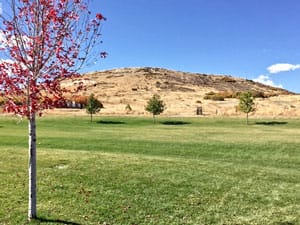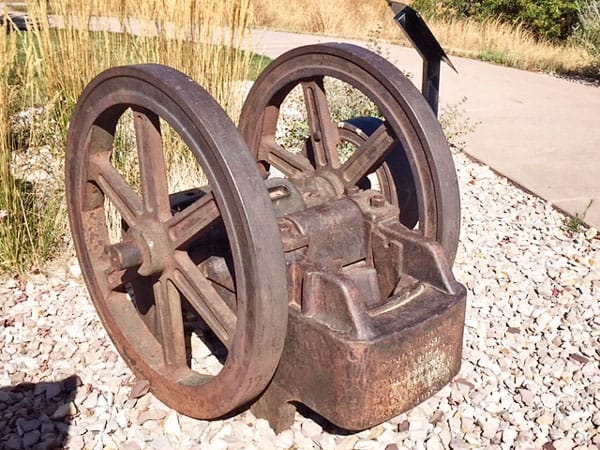Rhyolite: Tuff stuff launches early economic boom in Douglas County

Article and photos by Joe Gschwendtner

Madge Quarry was the town’s first rhyolite quarry and mainstay for 30 years.
Thirty-six million years ago a massive volcanic eruption near Mt. Princeton hurled molten rock and gases into Douglas County. Traveling nearly 100 miles per hour and landing in parts of Park and Teller Counties as well, the quick cooling ash created 15-30 foot layers of “Wall Mountain Tuff” classified as rhyolite. What didn’t wash away over eons remained intact, forming the buttes that pockmark our Wildcat Mountain area.
In 1872, while New Memphis and Castle Rock were vying to be the county seat, Silas Madge had a hunch about the butte on his ranch in today’s Crystal Valley. After a trip to the assayer, he learned with disappointment that there were no precious metals in the ore. But he was also informed that due to its structure, the grey to pinkish lava rock would make excellent building stone for which there was then, great demand in America.
Silas quickly put ranching on his back burner. Using local rock masons, many of them Swedish immigrants, a quarrying operation was launched. Rough business anywhere, the work was back-breaking. Fortunately, his experienced laborers helped him rapidly mechanize, moving from hand labor to mules and derricks, then constructing an incline tramway to move rock off the butte. By 1874 the Denver and Rio Grande had run a railway spur to his tramway terminus.
Silas’ success was no secret. Product was being shipped to Denver, Colorado Springs, and as far away as Cheyenne, Omaha and Kansas City. His rhyolite was used for the original Antler’s Hotel in Colorado Springs and Colorado College. His growing enrichment visible to all, the Pleasant O’Brien Quarry to his southeast opened 10 years later.

This Connecticut-made cast iron rock breaker/shaper, located at the entrance to Rhyolite Park in Crystal Valley, was used in Madge’s Quarry.
The Plateau Quarry under William Brown’s ownership also began operations in 1882 on the mesa south of today’s Silver Heights subdivision. Choosing not to build an incline, Brown hauled his variegated stone by horse and wagon over the current Castle Rock Parkway and Castle Pines Drive South to an existing Denver and Rio Grande spur, Plateau Station. Also called Mill No.2, it served Richardson’s Riley Gulch sawmill (on today’s Daniels Park Road). The station site itself sat just inside Gate #4 of today’s Castle Pines Village.
Douglas County’s last rhyolite diggings began in 1898 as the Santa Fe Quarry on the butte south of today’s Meadows community. Its prime mover was legendary Gus Nelson of Sedalia, seen as Douglas County’s Paul Bunyan. Lore tells of a local merchant who, stuck with an immovable 500 pound chunk of rock salt, offered it free to anyone who could remove it. This Mr. Nelson did with barely a grunt.
While Castle Rock rhyolite was monument quality, used in Union Station, Trinity Methodist Church, and in other architectural gems nationwide, rhyolite was limited to a 30-year run. By the new century, Portland concrete was both revolutionizing and dominating the construction industry because its amorphous format facilitated transportation and lowered shipping costs. Unfortunately, the industry ended like it started … on the rocks.
Wildcat Lore
The Connection features a column titled “Wildcat Lore.” As it turns out, the Castle Pines Connection serves residents of the Wildcat Mountains, a name pioneers and historians gave to the high country paralleling I-25 from Highlands Ranch and Lone Tree south to Castle Rock. Since the first territorial road (Daniels Park Road) bisected our mountains, there was no shortage of colorful characters parading through what are now private properties on the ridges of Douglas County. We plan to bring these grizzled and gutsy settlers alive again, vividly sharing their stories of grit and achievement in these Castle Pines.